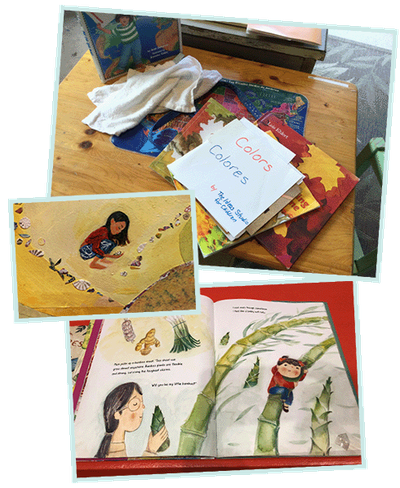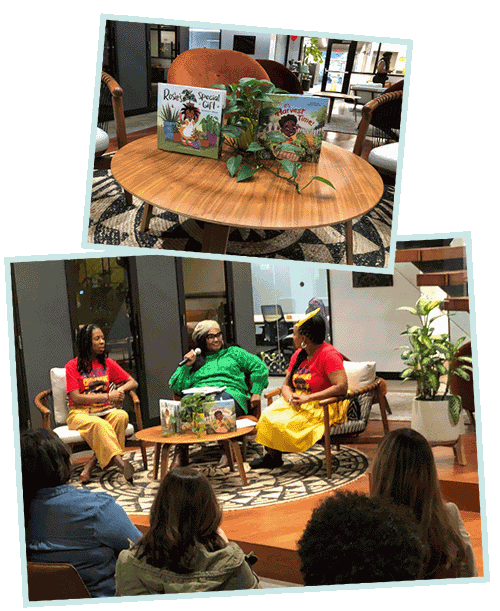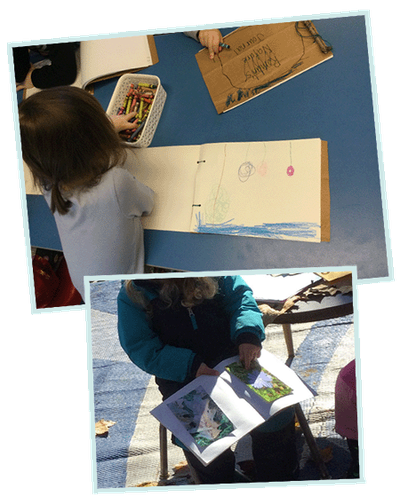Posted: April 11, 2024
For more than 50 years, people have been celebrating Earth Day on April 22nd. This is an opportunity for advocacy groups to bring attention to issues and attributes of our planet and all that nature provides, and how people can protect and enhance those experiences.
For early childhood education (ECE) and out-of-school time (OST) professionals, it is often a day where more time is spent outdoors, honoring nature and giving children extra, positive experiences interacting with the elements of life—earth, water, and air. Experts remind educators that almost every part of the programming day can be done outside. This is especially true about story time. If you'd like to celebrate Earth Day by having stories outside, here are a few new titles to consider. 
Earth Day Books
The Blueberry Awards are a recent addition to children's literature awards. They recognize excellent children's books about nature. A couple of the 2023 Blueberry honorees that might make good read-alouds for Earth Day are:
Title: We Are Branches
By: Joyce Sidman, illustrated by Beth Krommes
This book is a "celebration of a fascinating shape in nature. Branches are all around in butterfly wings, on gecko toes, in flowers, frost, and mud. Branches are nature’s most efficient way to spread and to connect. They are even found inside our own bodies. Branches—strong, hopeful, beautiful—are the shape of life."
Title: Bompa's Insect Expedition
By: David Suzuki with Tanya Lloyd Kyi, illustrated by Qin Leng
"The twins go on a nature expedition with Bompa. At first disappointed with searching right outside their door, they soon find world-champion flyers, eaters, and weightlifters with more tiny surprises at every turn!"
Title: One Tiny Treefrog: A Countdown to Survival
By: Tony Piedra & Mackenzie Joy
"In the tropical forest of Costa Rica, ten sticky frog eggs cling to a leaf. Only nine eggs hatch. Only eight tadpoles wind up in the water below. What will it take to survive the countdown to adulthood and begin the cycle again? This beautifully designed, color-drenched introduction to frog metamorphosis beautifully illustrates competition and natural selection."
Title: A Stone Is a Story
By: Leslie Barnard Booth, illustrated by Marc Martin
"'Where do rocks come from?' The answer may be more incredible than you think! Embark on a journey across time to see how one stone can change and transform, from magma under Earth's crust to the sand swept up by a rushing river to the very heart of the tallest mountain."
For the youngest children in the group, check out these award-winning books:
Title: The Babies and Bunnies Book!
By: John Schindel and Molly Woodward
"The babies and bunnies are just amazing. What the baby does, the bunny does, and vice versa."
Title: Leo on a Hike (A Leo Can! Book)
By: Anna McQuinn, illustrated by Ruth Hearson
"Leo is ready to hike. He and Daddy head out on the trail, observing all the wildlife along the way. They see tall trees, tiny flowers, and even some crawling bugs. Soon Leo is determined to explore on his own, following a busy bee and lingering to look at a slow worm."
Check out all the descriptions of this past year’s Blueberry Award winners and titles from 2022 and 2021.
Is your program located in an urban setting? Your children might relate to the experiences in:
Title: Rainbow Shopping
By: Qing Zhuang
The mom and daughter have a glorious time shopping in Chinatown on a rainy Saturday. "Mom picks up a bamboo shoot. 'This shoot can grow almost anywhere. Bamboo plants are flexible and strong, surviving the toughest storms. Will you be my little bamboo?' I nod, even though sometimes I feel like crumbly soft tofu."
A favorite book for families in rural areas might be:
Title: All the Places to Love
By: Patricia MacLachlan
The multi-generational family explores many parts of an expansive farm. And a young child makes plans to share their favorite spots with a newborn sibling, "I will send her messages downriver in small boats; I will watch her at the top of the hill, trying to touch the sky. I will show her my favorite place, the marsh…all the places to love are here."

Options for books about children and nature are everywhere.
Recently, two authors in the Lehigh Valley, PA teamed up for a book discussion during Black Children's Book Week. These women authors showcased books they had recently published that share positive messages about children and families and the benefits of gardening. The joys of gardening are palpable in the illustrations and simple storylines of these two books:
Title: It's Harvest Time!
By: Katarah Jordan
This book "celebrates the power of land and, family connection, and the joy of growing and sharing food…They learn about the importance of patience, care, and hard work, realizing that every member has a unique role to play in tending the garden… They believe in the power of community and sharing."
Title: Rosie's Special Gift: A Mother and Daughter Love Journey with Plants
By: Veronica H. Moore
This book celebrates the mother-daughter bond. "As they tend to their growing green things, Rosie and her mom uncover lessons about kindness, generosity, and the importance of community."
Building a Library
Selecting and reading books like these are ways to support regional authors and publishers. Do you have families who are strong advocates for the earth? Share your hopes with them. Ask if they will support this effort by purchasing some of these titles and donating them to your program.
Representation is an important consideration as you select books to share with children. Children need to see themselves in images in the pages of the books. Illustrations or photographs in the books should show a range of ages, abilities, and ethnicities. They should show a range of settings—rural, suburban, and urban. As children learn more about the world, it is wonderful to expose them to experiences and examples from all continents. The gardens and diets of the various regions of the United States are different from one another. And the United States' experiences differ from those in Tajikistan, Morroco, Patagonia, and the Soloman Islands.
Use this Improve your classroom library handout to think about and critique your current storybook offerings and how your book collection might be expanded and improved.
Whatever books you choose, choose ones that encourage children to wonder. "Is the sun the world's light bulb? Is dirt the world's skin?" Those are the intriguing questions that children in Micha Archer's Wonder Walkers book ask. And Joe Cepeda’s Rafa Counts on Papá will have children wondering and measuring how much and how many of all the things they explore outdoors!
“There is enormous power in reading to children, and that power is magnified when children are given opportunities to think about and discuss the books and stories shared with them. Children take great comfort in repeated engagement with familiar books and stories, and, since repetition is essential for learning, adults should rejoice when hearing a child exclaim, ‘Read it again!’” (White, 2024, para. 8).
So read these books for Earth Day, and then read them again on April 23rd, April 24th, May 6th, and May 7th… often. Make them available in the classroom so that children can revisit the images and storylines.
Create Books
Children can also author their own books about nature! Using blank books or making books invites children to draw and narrate stories. If your children want to explore mark-making and imagining stories, here are instructions for making simple sketchbooks with few materials.
- Easy-to-make mini sketchbook
- Easy-to-make staple-less booklet
- This Better Kid Care Tip Sheet provide additional ideas about how to weave storybooks into outdoor time.
Many advocates believe that children will not protect something unless they know and love it. Being outside, planting, playing, and watching are important steps for a child to take as they develop their own love for the earth. These books are an additional way to invite children to engage with the natural world at their feet, the natural world right in front of their eyes.
Reference
White, B. (2024). Leveraging the Science of Reading in your Early Childhood Program. Teaching Strategies

